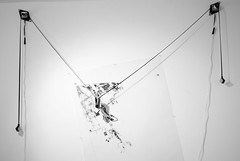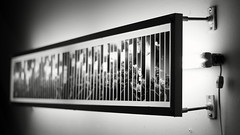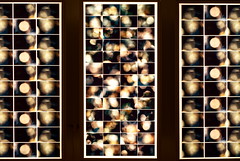
The whole affair is an informal tangle of common-looking parts, strung out to resemble a grandfather clock, controlled by a telephone, for the purpose of operating a tattoo gun. The 24x36 (?) paper attached to the gallery wall, upon which a drawing is--slowly--being formed by the jerking stylus, is almost beside the point. Moon's chief artistry seems to lie in the creation of the thing (machine) which creates what was formerly known as art, viz. a drawing.

Meanwhile, on an opposing wall, Xiao Tse's photographic prints are sustained by the steady glow of lightbox backlight. Tse's display shares a nominally "DIY aesthetic" with Moon's machine, as the re-purposed construction materials used by Tse are exposed to view, easily identifiable by the visitor. Curiously, Tse's chosen imagery is normally considered to be background rather than subject; and he's caused it (imagery) to be segmented, with white space left between individual units in a series.

While it's possible to count the number of aperture blades visible in Tse's lens' bokeh, or study the quality of Moon's machine's drawings, the meaning to be found in the exhibition (in toto) seems to stem from the peculiar manifestation of technology in the gallery space. In form and in spirit, Rob Ray's Deadtech is recalled from the not-too-distant past; and the Antena of Miguel Cortez is remembered from the present day.

The activity of Moon and Tse might be taken to indicate that it is possible to modestly harness science in the service of art; but, too, that indication might have more to do with the moderate nature of Moon and Tse than with the relationship they've (indirectly) proposed. Moon's machine in particular is infinitely scalable; the effect of the singular, rickety prototype ought not to be taken as the end towards which the machine might be made to progress. It's possible, for example, to imagine a large room filled with many similar mechanical artisans--each ticking away at the likeness of some predetermined form. Is the thought unappealing?
It seems good, now especially, to consider wherein the artistic act might be lost or found. Harvey Moon and Xiao Tse, taken together, do much to provoke such consideration. Though they seem not to have planned to exhibit their works together, their works are resonant--and timely.
Harvey Moon & Xiao Tse
"Mad Love"
Closing: Thursday, August 19, 2010
The Studio at 1020
1020 N. Marshfield
Chicago, IL
studio1020(at)gmail.com
Harvey Moon,
http://www.unanything.com
Xiao Tse,
http://jpgmag.com/people/forhours
- Paul Germanos
No comments:
Post a Comment